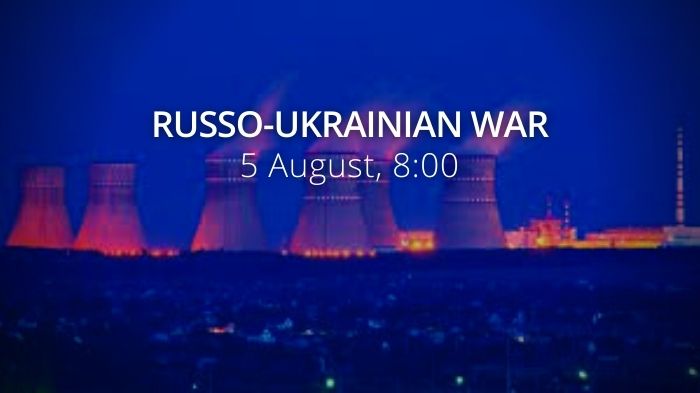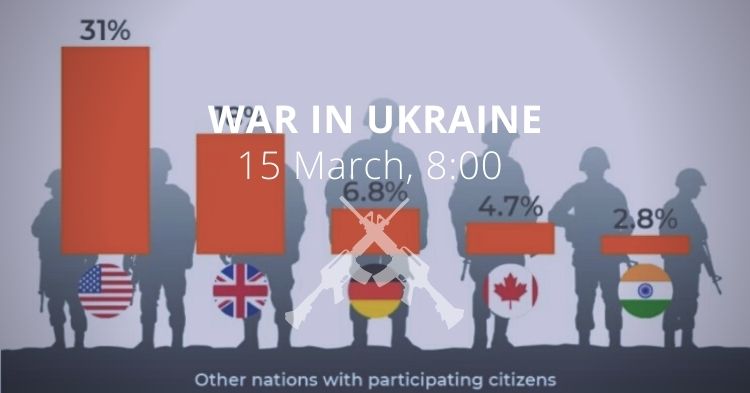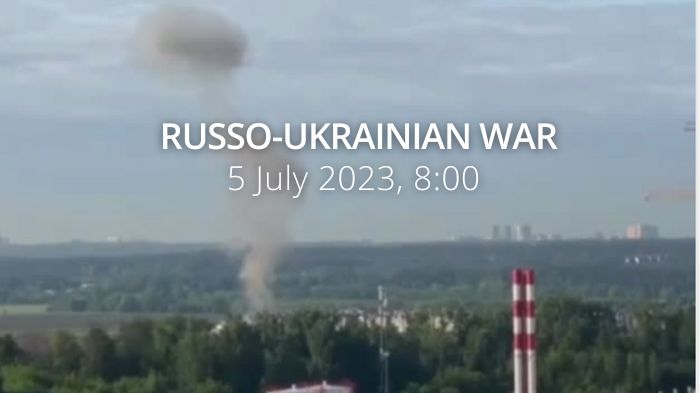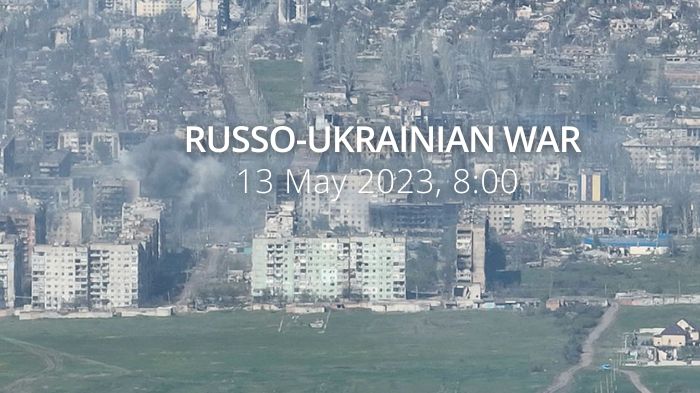Russian strike hits crowd at a bus stop in Toretsk, many dead. Russia is building up forces in the Zaporizhzhia and Kherson directions and de-conserving equipment. The Ukrainian army destroys four Russian S-300 launchers, and three ammo depots in the south of Ukraine. Ukraine’s missile and artillery units continue to target Russian military strongholds, personnel clusters, logistical support bases, and ammunition depots. Ukrainian army retakes two villages in eastern Ukraine. Amnesty International shifts blame to Ukraine. President’s Office responds to Amnesty International: “the only threat to Ukrainians is the Russian army.” Reznikov on Amnesty International: Attempts to question Ukrainians’ right to resist genocide are a perversion. Three new ships with grain leave Ukraine. NATO to establish a joint trust fund for Ukrainian needs.
Daily overview — Summary report, August 5
A map of the approximate situation on the ground in Ukraine as of 00:00 UTC 05/08/22. pic.twitter.com/U6UHJuJjP5
— War Mapper (@War_Mapper) August 4, 2022
[/box]

The General Staff’s operational update regarding the Russian invasion as of 06.00 am, August 5, 2022 is in the dropdown menu below.
“[Russian forces are concentrating their main efforts in the East of Ukraine to establish full control over the Donetsk and Luhansk oblasts within their administrative borders. Continues hostilities to hold the temporarily captured districts of Kherson and part of Kharkiv, Zaporizhzhia, and Mykolaiv oblasts. There remains a further threat of air and missile strikes on military and critical infrastructure facilities throughout Ukraine.]
[No signs of the creation of offensive groups of the armed forces of the Russian Federation and the Republic of Belarus were found.]
In the Volyn and Polissya directions, units of the Armed Forces of the Republic of Belarus are carrying out the task of strengthening the protection of the section of the Belarusian-Ukrainian border in the Brest and Gomel regions. In parts of the special operations forces of this country, a combat readiness check was held.
In the Siversky direction, Russian forces, with artillery and MLRS, shelled the civilian infrastructure in the areas of Zaliznyi Mist, Hay, Hremyach and Mikhalchyna Sloboda settlements in Chernihiv oblast and Starykovo in Sumy oblast.
- [To demonstrate the presence and restraint of the Defense Forces, Russian forces yesterday used artillery and MLRS to shell civilian and military infrastructure in the areas of Medvedivka, Mykolaivka, Chernihiv oblast and Krasnopilla, Myropilla, Mykhailivka, Velyka Rybytsia, Sumy oblast. Conducted aerial reconnaissance.]
[In the Slobozhansky direction:]
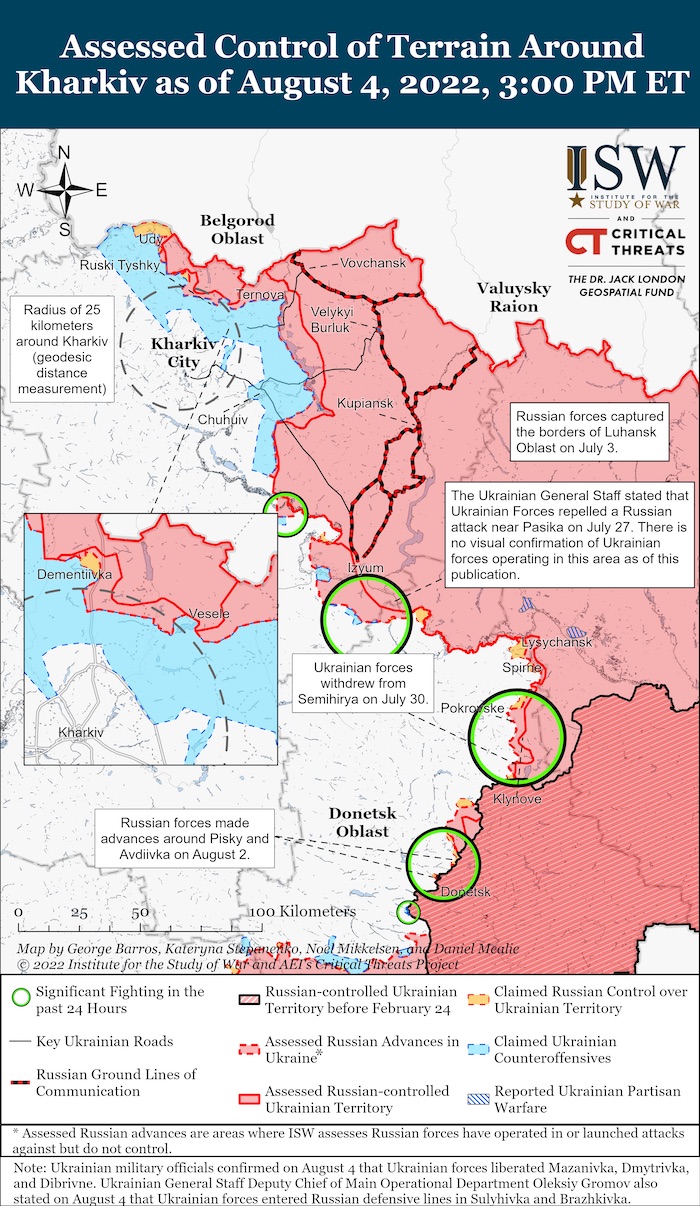
- In the Kharkiv direction, Russian forces carried out fire damage from artillery of various types in the areas of Kharkiv, Borschova, Korobochkine, Velyki Prokhody, Ruski Tyshki, Stariy Saltiv, Pryshyb, Tsyrkuny, Mospanove, Bezruky settlements. [Yesterday, Russian forces carried out fire damage from artillery and MLRS in the areas of the settlements of Kharkiv, Lebyazhe, Borshcheva, Dementiyivka, Korobochkyne, Velyki Prohody, Ruski Tyshky, Stary Saltiv, Pryshyb, Tsirkuny, Mospanove, Bezruki, Karasivka. Attempts are being made to break through the defences of our troops near Husarivka, hostilities continue.]
- In the Sloviansk direction, shelling was recorded near Bogorodichny, Mazanivka, Husarivka, Adamivka, Kurulka, Khrestyshe, Sulyhivka, Dovgenke, and Velyka Komyshuvakha. [Yesterday, Russian forces were using tanks, artillery and MLRS to shell the areas of the settlements of Bohorodychnye, Mazanivka, Husarivka, Adamivka, Kurulka, Khrestyshche, Sulyhivka, Dovhenke, and Velyka Komyshuvaha.]
- [Attempts by Russian forces to attack in the Dolyna and Bohorodychne areas yesterday, thanks to the skilful actions of our troops, ended in failure and retreat.]
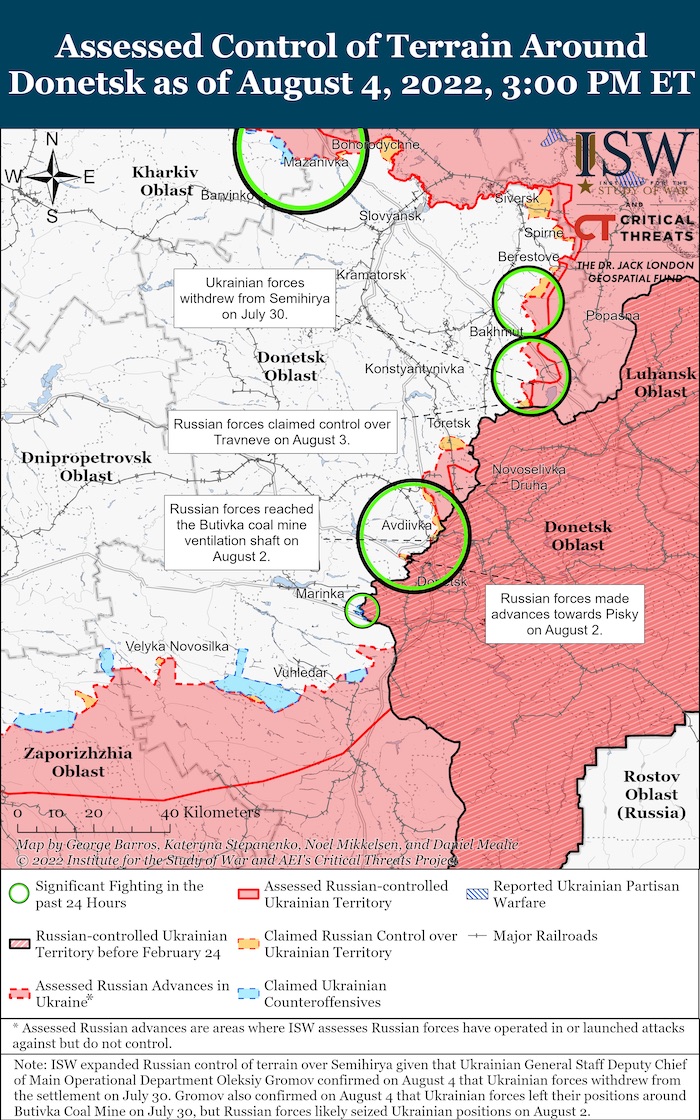
In the Donetsk direction, Russian forces are conducting an offensive operation in the Bakhmut and Avdiivka directions. It is trying to create favourable conditions for taking over Soledar and Bakhmut, to expand the controlled territory on the western outskirts of the city of Donetsk. [Yesterday, Russian forces were trying to dislodge units of the Defense Forces from occupied positions using tanks, artillery and MLRS. UAV conducted aerial reconnaissance of logistics support routes and critical infrastructure facilities.]
- In the Kramatorsk direction, shelling from artillery and MLRS, and tanks were recorded in the areas of Siversk, Mykolaivka, Starodubivka, Spirne, Kryva Luka, Verkhnyokamianske, Hryhorivka, Serebryanka, Raihorodok and Kalenyky settlements. There were shooting battles. [Yesterday, shelling was recorded near Siversk, Mykolaivka, Starodubivka, Spirne, Kryva Luka, Verkhnokamyanske, Hryhorivka, Serebryanka, Raihorodok, and Kalenyky.]
- In the Bakhmut direction, Russian forces shelled military and civilian infrastructure near Yakovlivka, Kodem, Pokrovsky, Rozdolivka, Vershyna, Bakhmut and Soledar. Conducted offensive and assault actions to improve the tactical position, but was unsuccessful. [Yesterday, Russian forces shelled military and civilian infrastructure near Pokrovske, Rozdolivka, Vershina, Yakovlivka, Bakhmut, Kodema and Soledar. Aviation was used for strikes near the last four settlements.]
- [Yesterday, the occupiers tried to improve the tactical position in the areas of Bakhmut, Soledar, Yakovlivka and Vershyna by assaulting them, but were unsuccessful and withdrew. Fighting continues near Travneve and Kodema.]
- In the Avdiivka direction, Russian forces fired artillery and tanks near Piski, Prechystivka, Shevchenko, Volodymyrivka, Novobakhmutivka, Nevelske, Netaylove, and Krasnohorivka. Conducted offensive actions, battles continue. [Yesterday, Russian forces fired from tanks and various types of artillery in the areas of Pisky, Prechystivka, Shevchenko, Volodymyrivka, Novobakhmutivka, Nevelske, Netaylove and Krasnohorivka settlements.]
- [Yesterday, Russian forces made another attempt of offensive actions in the area of the settlement of Pisky, but without success, hostilities continue.]
- No active actions of the occupiers were recorded in the Novopavlivsk and Zaporizhzhia areas. Russian forces carried out systematic shelling of civilian and military infrastructure near Constantinopol, Zaliznychne, Varvarivka, Vremivka, Mariinka, Hulyaipol, Hulyaipilskyi, Mali Shcherbaky, Temyrivka and Bilohirya. [Yesterday, Russian forces did not conduct active offensive actions but carried out shelling from tanks, artillery and MLRS along the entire line of contact. Carried out airstrikes near Novopola. It unsuccessfully tried to break through the defences near Mariinka, suffered losses and withdrew.]
In the Pivdenny Buh direction, Russian forces are concentrating their main efforts on preventing the advance of our troops. Supports the high intensity of UAV reconnaissance. [There remains a high intensity of shelling from the weapons of tanks and artillery at the positions of our troops along the contact line. Aerial reconnaissance by UAVs does not stop.]
- Shelling was recorded in the areas of Mykolaiv, Luch, Lymany, Nova Zorya, Novomykolaivka, Kobzartsi, Lyubomirivka, Kiselivka, Andriivka, Lozove, Bilohirka, Osokorivka, Potemkine, and Zeleny Hay.
- The occupiers launched a rocket attack on an infrastructural object in the Mykolaivka settlement of the Odesa region.
- [Yesterday, Russian forces carried out airstrikes in the areas of Mykolaiv, Luch, Lymany, Nova Zorya, Novomykolaivka, Kobzartsi, Lyubomirivka, Kiselivka, Andriivka, Lozove, Bilohirka, Osokorivka, Potemkine, Zeleny Hai, Bila Krynytsia, Balka Khutirska and Ivanivka.]
- [Yesterday, Ukrainian soldiers stopped a Russian offensive in the areas of Bilohirka and Lozove and drove the invaders back.]”
Military Updates
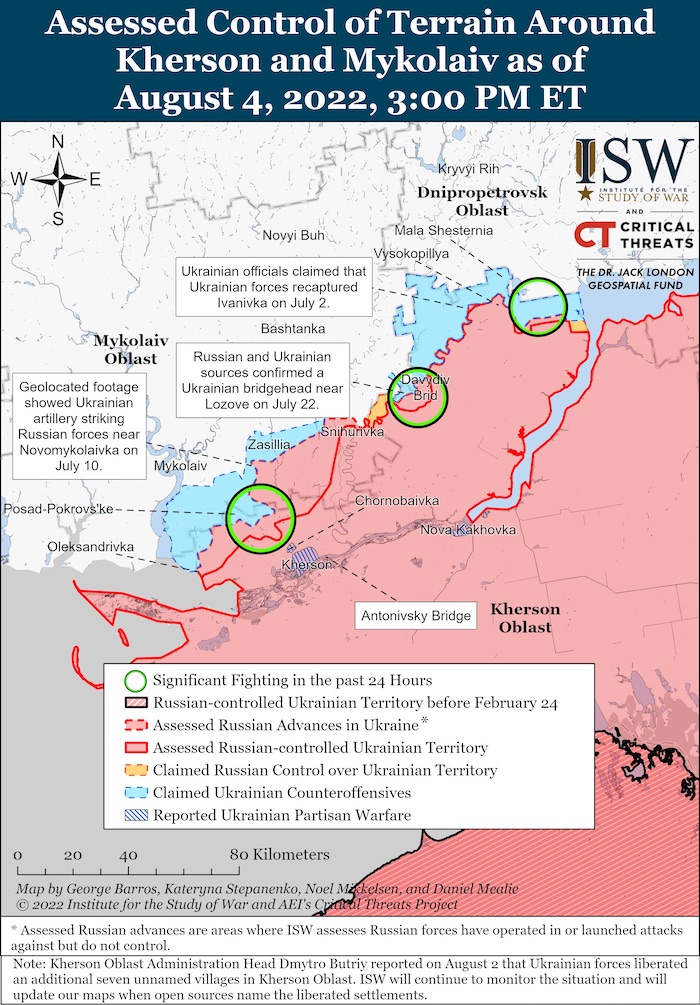
Russia is building up forces in the Zaporizhzhia and Kherson directions and de-conserving equipment” – stated Brigadier General Oleksiy Hromov, Deputy Chief of the Main Operations Department of the General Staff of Ukraine. Russia continues to use the “Syrian” experience – totally destroys civilian infrastructure and the civilian population by launching missile and air strikes. Also, Russian forces are building up their forces for long-term hostilities on our territory.
The occupier continues to increase its forces in the Zaporizhzhia and Kherson directions. The occupier transferred three battalion-tactical groups from the Novopavlovsk direction to the Kryvorizka direction, and also introduced one such group in the Zaporizhzhia direction,” said Brigadier General Hromov.
According to the brigadier general, Russia is replenishing forces and means through the Kerch bridge and the territory of Crimea. The peninsula is also used as a bridgehead for personnel and weapons. The redeployment of army aviation of the Eastern Military District to the territory of Crimea is noted. Russia continues to de-conserve equipment from long-term storage.
Russian forces’ positions in the captured territories continue to be noticeably strengthened, Hromov said. “A noticeable strengthening of Russian forces’s positions in the captured territories continues. A large amount of weapons and military equipment was brought to the north-eastern regions of Kherson. It is possible that Russian forces may or will try to carry out offensive actions deep into our defences in order to force the Armed Forces to stop expanding the bridgehead and go on the defensive,” he said.
According to separate information, detachments of the National Guard of Chechnya were stationed on the left bank of the Dnieper, which allegedly ordered to prevent the retreat of Russian troops from the right-bank Kherson region.
In the Kharkiv direction, Russian forces are not conducting active hostilities, are trying to hold the captured territories, and is also launching rocket attacks. The defence forces of Ukraine advanced into the depths of Russian forces’ defences and gained a foothold in the liberated territories, Brigadier General Hromov said.
On the Chernihiv, Konotop, and Sumy directions, Russian forces continue to shell, using various types of artillery. But the intensity of such shelling decreased from 50 to 39. One rocket shelling was recorded during the week.
The brigadier general noted that the probability of an attack from the territory of Belarus remains low. However, the threat of rocket attacks remains. Also, to distract the attention of the Armed Forces of Ukraine, a group of troops covering the state border of Russia has been deployed in the regions bordering Ukraine: These troops include conscripts or officers who refused to fight in Ukraine.
Oleksiy Hromov reported that a “volunteer headquarters” was organized in the Russian settlement of Valuyki. From this headquarters, transmissions for the Russian occupiers are delivered to the temporarily occupied territory of Ukraine, and looted property of Ukrainians is taken away from the territory of our state by civilian vehicles, he said.”
Ukraine Army destroys four Russian S-300 launchers, and three ammo depots in the country’s south, Ukrinform reports, citing Operational Command South. “On August 4, Ukrainian warplanes attacked two arms and equipment hubs set up by the Russian troops in the Kherson and Kakhovka districts.
The Ukrainian military destroyed a Russian stronghold in the temporarily occupied part of the Mykolaiv region in a helicopter strike. Meanwhile, the missile and artillery units of the Ukrainian Armed Forces attacked the Russian air defence network and logistics points, including ammunition depots, in the Kherson region – in the City of Kherson, as well as in Prydniprovsk and Tokarivka.
The command confirmed that the Russian occupying forces on the southern front lost 39 servicemen, four S-300 anti-aircraft missile systems, an Imbir radar station, a Voloshka 82-caliber automatic mortar, as well as nine trucks and armoured combat vehicles. The Armed Forces also destroyed three ammunition depots in Prydniprovsk, Kherson, and Tokarivka.
Ukrainian army retakes two villages in eastern Ukraine, Ukrinform reports, citing Oleksii Hromov, deputy chief of the main operational department of the General Staff of Ukraine. “During the week, our troops improved their tactical position and advanced deep into Russian forces’ defence lines outside the settlements of Mazanivka, Brashkivka, Sulyhivka and Dmytrivka. They liberated two settlements – Mazanivka and Dmytrivka, he said.”
https://twitter.com/DefenceHQ/status/1555120210964873216
According to British Defence Intelligence, (last 48 hours):
- Following five months of occupation, Russia’s intentions regarding the Zaporizhzhia Nuclear Power Plant remain unclear. However, the actions they have undertaken at the facility have likely undermined the security and safety of the plant’s normal operations.
- Russian forces are probably operating in the regions adjacent to the power station and have used artillery units based in these areas to target Ukrainian territory on the western bank of the Dnipro river.
- Russian forces have probably used the wider facility area, in particular the adjacent city of Enerhodar, to rest their forces, utilising the protected status of the nuclear power plant to reduce the risk to their equipment and personnel from overnight Ukrainian attacks.
- Ukraine’s missile and artillery units continue to target Russian military strongholds, personnel clusters, logistical support bases and ammunition depots. This will highly likely impact Russian military logistical resupply and put pressure on Russian military combat support elements.
- On 03 August 2022, the first vessel with Ukrainian grain arrived at the Bosphorus Strait having transited the Black Sea from Odesa. It is almost certain the success of this transit will result in more frequent transits in both directions. Clearing the backlog caused by the blockade that has been in place since February 2022 will remain a logistical challenge.
- Russian forces have almost certainly positioned pyramidal radar reflectors in the water near the recently damaged Antonivskiy Bridge and by the recently damaged nearby rail bridge, both of which cross over the Dnipro River in Kherson, southern Ukraine. The radar reflectors are likely being used to hide the bridge from synthetic aperture radar imagery and possible missile targeting equipment. This highlights the threat Russia feels from the increased range and precision of Western-supplied systems.
Losses of the Russian army
As of Friday 5 August, the approximate losses of weapons and military equipment of the Russian Armed Forces from the beginning of the war to the present day:
- Personnel – more than 41650 (+150),
- Tanks – 1792 (+3),
- Armoured combat vehicles – 4032 (+6),
- Artillery systems – 950 (+4),
- Multiple rocket launchers –MLRS – 260 (+1),
- Air defence means – 123 (+5),
- Aircraft – 223 (+0),
- Helicopters – 191 (+0),
- Automotive technology and fuel tanks – 2964 (+4),
- Vessels/boats – 15 (+0),
- UAV operational and tactical level – 742 (+0),
- Special equipment – 83 (+0),
- Mobile SRBM system – 4 (+0),
- Cruise missiles – 182 (+0)
Russian enemy suffered the greatest losses (of the last day) in the Donetsk direction.
As part of the replenishment of the Russian occupation forces, the possibility of transferring Russian servicemen from Syria to Ukraine is being considered, stated Brigadier General Oleksiy Hromov, Deputy Chief of the Main Operations Department of the General Staff of Ukraine. “The leadership of Russia is trying to stop the outflow of personnel from the army and therefore plans to change the legislation and prohibit dismissal from the ranks of the armed forces. In addition, there is low activity of the civilian population in signing contracts for military service. There is also a significant shortage of cadets for the military higher education institutions, said Oleksiy Hromov.”
⚰️russia's combat losses in Ukraine as of August 5
▪ 41650 killed soldiers (+150)
▪ 4032 APV (+6)
▪ 1792 tanks (+3)
▪ 950 artillery systems (+4)
▪ 223 aircraft and 191 helicopters
▪ 15 boats and cutters#StopRussia #StandwithUkraine pic.twitter.com/1w7ZyAhELr— VoxUkraine (@voxukraine) August 5, 2022
Humanitarian
https://twitter.com/EuromaidanPress/status/1555281165522698242
President’s Office responds to Amnesty International’s claim that the Armed Forces of Ukraine are endangering civilians, Ukrainska Pravda reports, citing a report by Amnesty International; Mykhailo Podoliak, adviser to the Head of the President’s Office, and Dmytro Kuleba, the Minister of Foreign Affairs. According to the report, “Ukraine’s tactics have violated international humanitarian law as they’ve turned civilian objects into military targets. The ensuing Russian strikes in populated areas have killed civilians and destroyed civilian infrastructure.”
“Experts from Amnesty reportedly examined the sites of Russian attacks in Kharkiv and Mykolaiv Oblasts and in Donbas between April and July. They interviewed survivors and witnesses and analysed satellite images. In the course of this research, the experts found “evidence of Ukrainian forces launching strikes from within residential areas as well as basing themselves in civilian buildings in 19 towns and villages in the regions.”
According to the Amnesty International report, most residential areas where soldiers located themselves were miles away from front lines and viable alternatives were available that would not have endangered civilians – such as military bases, densely-wooded areas or other structures further from residential areas.”
The Office of the President has responded that the only threat to Ukrainians is the Russian army, and Amnesty International’s claims are nothing less than participation in Russia’s defamation campaign against Ukraine.
Today Russia is making maximum efforts to discredit the Armed Forces of Ukraine in the eyes of Western societies and disrupt weapons supplies using its entire network of influence agents. It is a shame that an organisation like Amnesty International is participating in this disinformation and propaganda campaign. Podoliak also added that the only thing that poses a threat to Ukrainians is the Russian army of executioners and rapists that came to Ukraine to commit genocide.”
Podoliak stressed that Ukrainian soldiers are defending their nation and their families. People’s lives are the unconditional priority for Ukraine. That is why we are evacuating residents of frontline cities, Podoliak concluded.
Kuleba, for his part, said he is outraged by Amnesty’s claim and considers it unfair. This behaviour by Amnesty International is not about the search for truth and bringing this truth to the world. It is about creating a false balance between criminal and victim, between a country which is destroying thousands of civilians and whole cities, and a country which is desperately defending itself, saving its population and the whole continent from this onslaught.”
https://twitter.com/EuromaidanPress/status/1555197905023156224
Reznikov on Amnesty International: Attempts to question Ukrainians’ right to resist genocide are a perversion, Ukrainska Pravda reports. “Any attempts to call into question Ukrainians’ right to resist genocide, to defend their families and homes, to defend their lives and those of their children, and to resist the actions of Russia as a terrorist state, are a perversion, no matter what legal constructions they are dressed up in.
Any attempts to equate the unprovoked Russian aggression with the Ukrainian defence, even in passing, as was done in the Amnesty International report, are evidence that the organisation has lost common sense and is trying to ruin its own authority.
Ukraine is a rule-of-law state. We are analysing and assessing war events comprehensively, including from a legal point of view, as our obligations require. But we won’t allow anyone to defame our army, our defenders. I say that as a lawyer.”
Reznikov stressed that the selfless and heroic actions of the Armed Forces of Ukraine are the only reason why hundreds of thousands of Ukrainians are still alive and have a home.”
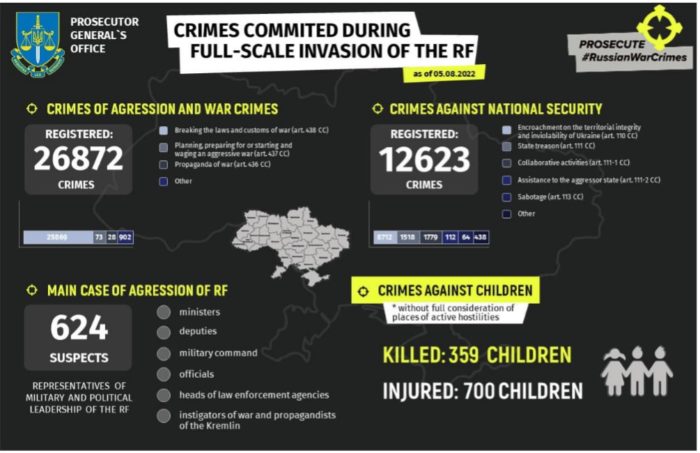
211 children reported missing in Ukraine amid war with Russia – police, Ukrinform reports. “In the period from February 24, National Police bodies received reports about 4,353 missing children. Law enforcement officers managed to find 4,143 children, and 211 are still missing, Oleksii Serhieiev, head of the department for organizational and analytical support and rapid response of the National Police, said.
Since the beginning of May, 30,000 school-age children who were forced to leave abroad have returned to Ukraine
According to Minister of Education and Science Serhii Shkarlet, currently, there are 641,000 Ukrainian school-age children abroad.https://t.co/jrujxvp8Od
— Euromaidan Press (@EuromaidanPress) August 4, 2022
Serhieiev specified that about 190 children received appeals from close relatives that they lost contact with them after the occupation of the regions of permanent residence or during the evacuation from such regions.”
Millions of refugees from Ukraine have crossed borders into neighbouring countries, and many more have been forced to move inside the country. The escalation of conflict in Ukraine has caused civilian casualties and destruction of civilian infrastructure, forcing people to flee their homes seeking safety, protection and assistance the UNHCR reports. As of 3 August:
| Individual refugees from Ukraine recorded across Europe: | 6,307,137 |
| Belarus, Hungary, Republic of Moldova, Poland, Romania, Russian Federation, Slovakia | 3,522,611 |
| Other European countries | 2,784,526 |
| Refugees from Ukraine registered for Temporary Protection or similar national protection schemes in Europe: | 3,782,154 |
| Hungary, Poland, Romania, Slovakia | 1,421,916 |
| Other European countries | 2,360,238 |
| Border crossings from Ukraine (since 24 February 2022): | 10,350,489 |
| Border crossings to Ukraine (since 28 February 2022): | 4,272,233 |
OHCHR recorded 1,455 civilian casualties in Ukraine in July. 355 were killed (including 15 children) and 1,100 injured (including 58 children).
️️Environmental
UA intel identified collaborators & foreign vessels helping Russia steel 650,000 tons of UA grain worth $5,4 mn from Kherson, Zaporizhia oblasts
Vessels under flags of Russia, Syria &5 more foreign sea vessels were steeling UA grain. Investigation ongoing https://t.co/h7KyU1iEAh pic.twitter.com/faj7daXxZJ
— Euromaidan Press (@EuromaidanPress) August 4, 2022
Three new ships with grain leave Ukraine under landmark deal, Reuters reports. “Three ships loaded with grain under a recently concluded deal have left Ukrainian ports. The Joint Coordination Centre in Istanbul, which groups Russian, Ukrainian, Turkish and UN personnel, said two ships were setting off from Chornomorsk and one from Odesa. The three vessels carrying a total of about 58,000 tonnes of corn have been authorised to leave Ukrainian ports as part of a deal to unblock grain exports.
The Turkish Defence Ministry said on Twitter the Panama-flagged Navistar, carrying 33,000 tonnes of corn and going from Ukraine to Ireland, departed from Odesa Port. The ship will be inspected by the Joint Coordination Centre to the north of Istanbul.
The second ship, the Maltese-flagged Rojen, carrying 13,000 tonnes of corn departed from Chornomorsk port bound for Britain. The Joint Inspection Team was monitoring it.
The Turkish-flagged ship Polarnet set off from Chornomorsk for the Turkish Black Sea port of Karasu. Before the ship carrying 12,000 tonnes of corn reaches Karasu, it will be inspected by the Joint Inspection Team to the north of Istanbul.”
https://twitter.com/EuromaidanPress/status/1555312630902005763
Global energy crisis drives rethink of nuclear power projects, Reuters reports. “Governments across Europe and Asia are extending their ageing fleet of nuclear plants, restarting reactors and dusting off plans to resume projects shelved after the 2011 nuclear crisis in Fukushima, Japan. Both the administration of US President Joe Biden and the International Energy Agency has said nuclear power is critical for countries to meet global net-zero carbon emissions goals and ensuring energy security, as fossil fuel prices have surged after Russia cut natural gas supplies to Europe since the Ukraine war started.
As a result, nuclear power may be on the cusp of a revival of the golden age seen after the 1970s oil crisis that led to a flurry of projects, although opposition from politicians and non-governmental organizations, funding issues and safety concerns will have to be overcome.
“If fossil fuel prices remain high for a period of three to four years, I think that would be enough to launch a golden age of nuclear development especially in Asia because that’s where they are the most price sensitive and because there’s most need,” said Alex Whitworth, head of Asia power and renewable research at consultancy Wood Mackenzie. […] In Europe, there are only a few nuclear power stations under construction but France has plans for up to 14 new reactors by 2050.
The European Union labelling nuclear power investments as climate-friendly earlier this month is also expected to unleash public and private funding for new projects.”
Legal
Russia aims to fabricate evidence in Olenivka – US, European Pravda reports. According to AP, “US intelligence officials have determined that Russia is trying to plant false evidence to blame Ukrainian troops for the July 29 strike on Olenivka, which killed 53 people and injured dozens more. Russia claims that the Ukrainian military used US-supplied rocket launchers to shell Olenivka. The Ukrainian military denied launching any rocket or artillery strikes on Olenivka.
The official, who was not authorized to comment publicly and spoke anonymously, said the classified intelligence shows the Russians might even plant ammunitions from the HIMARS as evidence that the provided by the US systems were allegedly used in the attack. Russia is believed to be taking such measures as it expects anticipates investigators and journalists to eventually get access to Olenivka, the official added.
On Wednesday, UN Secretary-General Antonio Guterres announced launching a fact-finding mission into an attack in the front-line Ukrainian town of Olenivka that killed prisoners held by Moscow-backed separatists. He told reporters he doesn’t have authority to conduct criminal investigations but does have authority to conduct fact-finding missions.”
https://twitter.com/EuromaidanPress/status/1555186793615478785
Toretsk: Russian strike hits crowd at a bus stop, many dead, Ukrainska Pravda reports, citing Pavlo Kyrylenko, the head of the Donetsk Oblast Military Administration. “8 dead, 4 wounded – these are the consequences of the shelling of Toretsk, which the Russians carried out today at about 11 o’clock. Three of the four wounded are children.”
https://twitter.com/EuromaidanPress/status/1555322118472073218
359 children were killed, and 700 children injured, the Office of the Prosecutor General of Ukraine reports as of August 5. 2,211 educational establishments are damaged as a result of shelling and bombings, 230 of them are destroyed fully. 26,872 crimes of aggression and war crimes and 12,623 crimes against national security were registered.
Support
https://twitter.com/EuromaidanPress/status/1555259519432892423
Following MBT supplies, North Macedonia will give Ukraine four Su-25 jets, Ukrinform reports. “The Ministry of Defense of North Macedonia announced that it has decided to hand over to Ukraine four Su-25 attack aircraft. This was reported by the local publication MKD. The country’s defence officials reported that the planes had been in storage since 2003 and were not used by the nation’s army.
It should be noted that back in 2001, during the conflict in the Balkans, North Macedonia bought the said warplanes from Ukraine. Su-25s, designed to support infantry, have flown several sorties during the conflict to support the local security forces’ ground operations. Late July, North Macedonia handed over to Ukraine a batch of T-72 tanks, the exact number of which has not been reported.”
https://twitter.com/EuromaidanPress/status/1555291483883704320
Canada to help train Ukrainian recruits in the United Kingdom, Reuters reports. “Canada will send up to 225 personnel to the United Kingdom to train Ukrainian military recruits, starting with the first troops next week, Canadian Defence Minister Anita Anand said on Thursday.
The Canadian Armed Forces have trained more than 33,000 Ukrainian military and security personnel since 2015 but paused aspects of the training effort since February. We have now entered a new and very dangerous phase of this conflict with (Russia) engaging in a protracted attempt to inflict long-term damage on Ukraine and its people, Anand said in Toronto.”
Japan to provide vans and drones to Ukraine, Ukrinform reports. The press service of the Japanese Ministry of Defense said this in a statement on Thursday. “In response to a request from the Ukrainian side, we will provide new civilian vehicles (vans) to the Ukrainian government. We will also hand over additional small drones,” the statement said. Earlier, the Ministry of Defense and the Self-Defense Forces of Japan provided body armour, helmets, protective masks, protective clothing, small drones, etc. to Ukraine. The Ministry of Defense and the Self-Defense Forces will continue to provide as much support as possible to Ukraine, the statement said.”
NATO to Establish Joint Trust Fund for Ukrainian Needs – Office of the President of Ukraine, European Pravda reports. “There used to be up to six NATO trust funds that financed various assistance types. Some financed demining, some – training of military personnel, etc. Today, NATO plans to establish a joint trust fund to finance the relevant needs of Ukraine. By the way, humanitarian demining is very important. This work has already begun. We need appropriate specialists, equipment, and funds. NATO is ready to back us, which is significant, LB.ua quotes Deputy head of the Office of the President of Ukraine, Ihor Zhovkva.
According to him, as an institution, NATO cannot provide Ukraine with lethal weapons, but it will do everything possible to supply non-lethal weapons. By the way, it is also no less important in times of war. We need additional fuel and lubricants, means of combating unmanned aerial vehicles, medicines, first-aid kits by NATO standards, etc., Zhovkva noted.
As previously reported, President of Ukraine, Volodymyr Zelensky, in a conversation with NATO Secretary General Jens Stoltenberg, stated the need to receive more heavy weapons from the Alliance states to repel Russian attacks and a counteroffensive by the Armed Forces of Ukraine.”
NATO members working with defence companies to boost weapons supplies to Ukraine, Reuters reports. “NATO members are working closely with defence companies to ensure Ukraine gets more supplies of weapons and equipment to be prepared for the long haul in its war with Russia, NATO Secretary-General Jens Stoltenberg said on Thursday.
We are providing a lot of support but we need to do even more and be prepared for the long haul,” Stoltenberg told Reuters in an interview. Therefore we’re also now in close contact and working closely with the defence industry to produce more and to deliver more different types of ammunition, weapons and capabilities, he said.
Stoltenberg said separately in a speech in Norway to local Labour party activists on Thursday that Russia’s invasion of Ukraine, which Moscow calls a “special military operation”, had created the most dangerous moment for Europe since World War Two and that Russia could not be allowed to win.”
Spain allocates almost EUR 53M in financial support for Ukrainian refugees, Ukrinform reports. “The government of Spain has approved the allocation of EUR 52.8 million in direct financial assistance to Ukrainians who have obtained temporary protection in this country.
The funds, in particular, will go to autonomous communities in Spain where Ukrainians live. It is expected that payments of the new package of direct assistance will amount to EUR 400 per month for adults and EUR 100 for minor Ukrainians. The financial assistance will be provided within six months. Spain has hospitably sheltered more than 137,000 our citizens, which is the fourth highest figure among EU countries.”
New Developments
- The Office of the President of Ukraine cites 4 necessary components for negotiations with Russia, Ukrainska Pravda reports, citing Mykhailo Podoliak, advisor to the head of the Office of the President. “To talk with Russia, it is important to have the right negotiating position. This consists of four simple components: 1. Long-range artillery, MLRS and ATACSMS (Army TACtical Missile System) to destroy Russian logistics. 2. Air defenсe/anti-missile defenсe to protect cities. 3. Strike drones – the best hunters. Armoured vehicles for counterattacks.”
- NATO chief: Ukraine war is Europe’s most dangerous time since WW2, Reuters “The war in Ukraine is the most dangerous moment for Europe since World War Two, and Russia must not be allowed to win, NATO Secretary-General Jens Stoltenberg said on Thursday. To prevent Moscow from succeeding, NATO and its member countries may have to continue to support Ukraine with arms and other assistance for a long time to come, he said.”
- UN aims to launch a mission investigating the circumstances of the killing of Ukrainian PoWs at the Olenivka prison camp, Ukrainska Pravda reports, citing Radio Free Europe/Radio Liberty. “Antonio Guterres, UN Secretary-General, has said that the international organisation wants to launch a mission to establish the circumstances of the killing of Ukrainian PoWs in occupied Olenivka, Donetsk Oblast.”
https://twitter.com/EuromaidanPress/status/1555164144390836224
Assessment
- On the war.
map source: https://www.understandingwar.org/backgrounder/russian-offensive-campaign-assessment-august-4*
The Institute for the Study of War has made the following assessment as of 4 August, 2022:
- On the War
According to Ukraine's General Staff, Ukraine regained territory around Izium (blue zone) – DeepState
Bohorodychne, Dmytrivka, Dibrivne & Mazanivka are recaptured. Fighting is now going on for Sulyhivka and Brazhkivka (Grey zone): https://t.co/Z5p8DbXBDw pic.twitter.com/tsUfTJeIwz
— Euromaidan Press (@EuromaidanPress) August 4, 2022
“Ukraine is likely seizing the strategic initiative and forcing Russia to reallocate forces and reprioritize efforts in response to Ukrainian counteroffensive operations. Russian forces are increasingly transferring personnel and equipment to Kherson and western Zaporizhzhia Oblasts at the expense of their efforts to seize Sloviansk and Siversk, which they appear to have abandoned. Russian forces are also redeploying military equipment – artillery and aviation in particular – to Crimea from elsewhere in Ukraine. Russian forces have previously withdrawn from or suspended offensive operations on Kharkiv City and the southern axis to prioritize capturing Luhansk Oblast, but they did so on their own initiative based on the changing priorities of their commanders. Russian forces in this case appear to be responding to the Ukrainian counteroffensive threat in Kherson Oblast rather than deliberately choosing objectives on which to concentrate their efforts. Even after Ukrainian forces defeated the Russian attempt to seize Kyiv early in the war, the Russians were able to choose freely to concentrate their operations in the east. Ukraine’s preparations for the counteroffensive in Kherson and the initial operations in that counteroffensive combined with the dramatic weakening of Russian forces generally appear to be allowing Ukraine to begin actively shaping the course of the war for the first time.
The seriousness of the dilemma facing the Russian high command likely depends on Ukraine’s ability to sustain significant counteroffensive operations on multiple axes simultaneously. If Ukraine is able to press hard around Izium as it continues rolling into the counteroffensive in Kherson, then Russian forces will begin confronting very difficult choices. They will likely need to decide either to abandon their westward positions around Izium in favor of defending their ground lines of communications (GLOCs) further north and east or to commit more personnel and equipment to try to hold the current front line. Such forces would have to come from another axis, however, putting other Russian gains at risk.
Russian forces are likely operating in five to seven strike groups of unclear size around Bakhmut, based on the Ukrainian General Staff descriptions of Russian assaults in the area. Recent Ukrainian General Staff reports have most frequently identified Vershyna, Soledar, Kodema, Bakhmut, and Yakovlvka as the repeated targets of localized concentrated Russian efforts around Bakhmut. The Russian groups attacking these targets are reportedly operating out of the nearby settlements of Pokrovske, Streapivka, Roty, Semihirya, and Vidrozhnnya for now.
Explosions occurred near the Donetsk Drama Theater and Penal Colony #124 in occupied Donetsk City on August 4. Russian media widely publicized the explosions and blamed Ukrainian artillery, but the Ukrainian Office of the President denied any shelling of Donetsk City on August 4. The limited damage visible in the videos Russia has produced as evidence of the Ukrainian attack near the Donetsk Drama Theater appears to be inconsistent with artillery shelling. Russian officials have not provided footage of the reported attack on Penal Colony #124. Russian milbloggers widely published the Russian-provided footage of the aftermath of the explosion near the Donetsk Drama Theater and used the opportunity to harshly criticize Ukrainian forces for alleged strikes on civilian targets. Were the explosions Ukrainian shelling, they would carry further emotional weight with DNR supporters because they occurred during a farewell ceremony for an occupation forces officer KIA on August 3. Russian forces likely hope to use the emotional response of DNR audiences to such claimed Ukrainian attacks to garner support for new offenses in the Avdiivka area and further recruitment campaigns.
Key Takeaways
- Ukraine is likely seizing the strategic initiative and forcing Russia to reallocate forces and reprioritize efforts in response to Ukrainian counteroffensive operations.
- Russian forces attempted to advance northwest of Izium.
- Ukrainian forces conducted a series of localized counterattacks between Izium and Sloviansk and regained positions in a number of settlements.
- Russian forces continued ground attacks northeast and south of Bakhmut.
- Russian troops continued attempts to advance on Pisky and conducted a limited ground attack southwest of Donetsk City.
- Russian forces continued to transfer equipment and personnel to northeastern Kherson and western Zaporizhzhia Oblasts.“
Russia’s Shortfalls Create an Opportunity for Ukraine, Western Officials Say, The New York Times reports. “Severe equipment and manpower problems could slow President Vladimir V. Putin’s mission as the war enters its sixth month. In the early phase of the war in Ukraine, shortages of soldiers and problems with equipment forced Russia to narrow its mission, abandon its assault on Kyiv and focus its offensive on the east.
Now, as the fighting enters its sixth month, critical manpower and equipment problems could again slow Russian operations and give Ukraine’s counteroffensive a better chance to succeed, US and European officials said. The signs of Russia’s challenges abound: artillery shells missing their targets, intercepts of Russian soldiers complaining they have been given old tanks and a sharply rising death and injury toll in its military ranks. But unlike earlier in the war, it could become harder for Russia to reset its strategy and recover, at least in the short term.
US and European officials say few powers have conquered a country and destroyed an opposing army with a mostly volunteer force, as President Vladimir V. Putin of Russia is attempting to do. But Mr. Putin has shown no indications that he wants any sort of full-scale draft, which would amount to an admission to his country that the fight in Ukraine will be a long war, not a short operation. […]
NATO and other officials say the reality on the ground should force the Russian military to slow its operations to reinforce depleted units, better protect its supply lines and move in new equipment. These officials concede it is possible that Mr. Putin could override the advice of his officers and order the drive in the east to continue through the summer. For all of Russia’s equipment and manpower issues, high energy prices mean Moscow is making enough money to fund its military. […]
The Russian shortfalls have created an opportunity for the Ukrainian army, driving their decision to launch a counteroffensive, said senior US military officials and American lawmakers who have visited Ukraine recently. More Ukrainian offenses, most likely in the south, are likely in the coming weeks, these officials said. […]
Russia has committed nearly 85 percent of its fielded army to the fight in Ukraine, drawing on troops from the country’s far east and deployments around the world, a senior Defense Department official said recently. The Russian military, European officials said, has been hard-pressed to bring reservists and new recruits into the fight. […]
In its search for recruits, Russia has had to lower its standards, Western intelligence officials said. Mr. Putin signed a law eliminating the age limit for Russians to sign their first contract to join the military. Western officials also said they have assessed that the Russian military is lowering health and fitness standards and giving waivers to people with criminal records to join.
Russia has tried to make up some of its manpower shortages using mercenaries from the Wagner Group, a private military force with ties to Mr. Putin. American intelligence reports have said that while mercenaries could make a difference in specific battles, there are not enough of them to make a strategic difference in the larger war, according to officials briefed on the assessments.
American officials said Russia’s biggest problem is Mr. Putin’s unwillingness to announce a wider draft. So far, the Russian military has been unable to recruit enough men fast enough to make up for the soldiers killed and wounded in action.
Even if Russia decided to press more reservists and conscripts into service, Western intelligence officials say Mr. Putin would face a severe bottleneck. The Russian military has already deployed many officers and instructors who would train conscripts or reservists to the front lines, a decision one Western intelligence official compared to eating the seed corn. Russia delayed its spring draft by two months, a sign it could not train those who were willing to serve, the Western officials said.
While not as acute as its manpower shortage, Russian equipment problems are significant. Russian forces, for example, have had to replace newer, more modern tanks with older versions. By some intelligence estimates, Russia has lost a third of its tanks. As it uses up stocks of precision-guided missiles, Russia has relied on artillery systems. But Ukraine’s use of sophisticated weaponry has forced Russia to push them back from the front lines, diminishing their effectiveness.
Russia has a huge supply of artillery shells, the prime munition it is using in this stage of the war, American officials said. But even with those, there are problems, according to Western intelligence officials. Many are ageing and were stored in poor conditions, reducing their effectiveness by making their fuses unreliable.
US and European export controls have effectively put pressure on Russian arms manufacturers, at least temporarily, forcing them to slow or halt production of high-end guided and other advanced munitions. The shortage has forced Russians to be judicious in their targeting — one reason the military has limited its attempts to strike moving convoys and instead focused on stationary targets like Ukrainian warehouses.
In recent weeks, Russia has been using an antiaircraft system, the S-300, to strike ground targets near the city of Mykolaiv, a sign, Ukrainian officials said, that Russia lacks missiles better suited for such attacks.
Senior US military officers said the Russian shortages in manpower, weapons and munitions are already playing out on the battlefield. New Ukrainian tactics — enabled by Western equipment — have also effectively curbed the number of shells available at any time to Russian frontline troops.
Ukrainian soldiers have used American-supplied weapons like the High Mobility Artillery Rocket Systems, or HIMARS, to destroy dozens of Russian command posts, air defence sites and ammunition depots, disrupting the flow of munitions to frontline Russian forces.
Brig. Christopher King, the top British officer at a military cell in Stuttgart, Germany, that is coordinating the flow of donated Western arms and ammunition into Ukraine, said the HIMARS and other rocket artillery have allowed the Ukrainians to slow the Russians’ “ability to supply themselves, which is exactly why we provided that to them.”
Ukrainian artillery and tanks, of course, have also been destroyed. And a senior Ukrainian military official said like the Russian military, Ukraine had lost some of its best officers and soldiers in the first months of the conflict. But, the official added, Kyiv had far more officers with years of frontline fighting experience, which proved decisive in the first phase of the war.
American and Western intelligence assessments lend credence to the idea that the next weeks or months will be critical for Ukraine. Even if Russian forces cannot be pushed back significantly, a strong counteroffensive could increase confidence among Ukraine’s allies.
American and British officials said Ukrainian officials have said they understand they have a limited amount of time to take advantage of Russia’s apparent weakness.”
Consequences and what to do?
Hans Petter Midttun: “Now, as the fighting enters its sixth month, critical manpower and equipment problems could again slow Russian operations and give Ukraine’s counteroffensive a better chance to succeed, US and European officials said. American and Western intelligence assessments lend credence to the idea that the next weeks or months will be critical for Ukraine. American and British officials said Ukrainian officials have said they understand they have a limited amount of time to take advantage of Russia’s apparent weakness.”
All of the above is correct. The Russian Armed Forces are facing significant problems, including lack of manpower, lack of precision-guided munition, lack of intelligence, poor command and control, technical problems, design flaws, poor logistics, and more.
Unfortunately, Ukraine is also facing challenges despite being supported by the USA, the EU, NATO and several other international partners. Ukraine has continuously asked for more substantial and faster support to enable it to take advantage of what the Defence Intelligence of Ukraine in May already predicted to be a Russian culmination point in August.
Despite the Ukrainian requests, the West has continued to supply “single digit pieces” of weapons. Its partners are not supplying weapons in a sufficient quantity to replace equipment lost on the battlefield. Ukraine has lost at least 1,400 vehicles and equipment so far. That is losses that have been documented. The actual amount of equipment destroyed or lost is, therefore, significantly higher. As of mid-June, Ukrainian brigades had lost approximately 30 to 40, sometimes up to 50 percent of their equipment as a result of combat. Two months ago, approximately 1,300 infantry fighting vehicles, 400 tanks, and 700 artillery systems had been lost. To make things worse, Ukraine’s international partners have not even delivered all of the weapons that have been pledged. Some countries even stand accused of delaying their deliveries.
We have refused to provide it with long-range weapons to enable it to continue to target Russian military strongholds, personnel clusters, logistical support bases and ammunition depots as the enemy is adapting its tactics to the introduction of HIMARS to the battlefield. High-value targets – the ones eligible for attacks by the extremely limited number of HIMARS – are being moved out of range of the ammunition supplied.
Additionally, the NATO members continue to deny Ukraine combat aircraft. Medium and Long-Range Air Defence systems have not yet been delivered. NATO -arguing that it is trying to avoid a full-scale confrontation with Russia – stands firm on its decision not to establish a No-Fly Zone over Ukraine and the Black Sea. The Alliance has been deterred by Russia and has stepped away from its past commitment to stop conflicts threatening to impact the security of its member states and has decided to provide Ukraine with nonlethal support only. NATO continue to avoid its responsibility to uphold Freedom of Navigation in the Black Sea, and therefore, globally. It remains unwilling to break the maritime embargo that is slowly strangling the Ukrainian economy, thereby undermining the economic viability of the state.
The assessment that Russian problems give Ukraine’s counteroffensive a better chance to succeed, rings hollow given NATO’s failure to commit.
If a coalition of the willing – the future substitute for NATO – were to decide to do what the USA did during WW1 and WW2 – to engage actively to protect democracy against autocracy, the military power would change dramatically in favour of Ukraine. The problems Russia is facing today would become overwhelming. The psychological impact alone might help break the will to fight.




